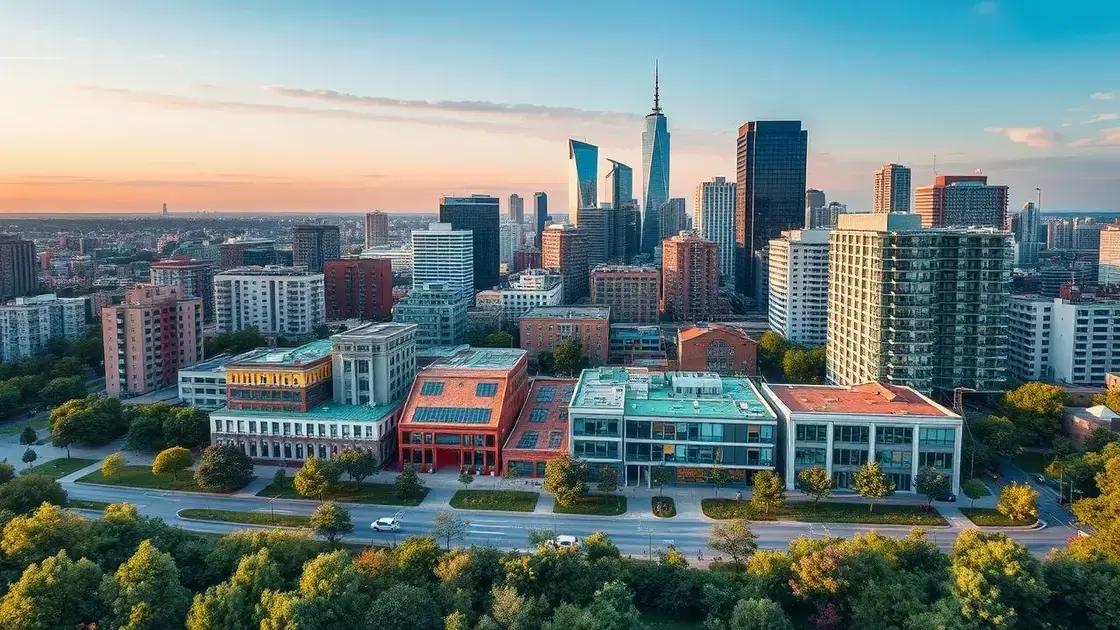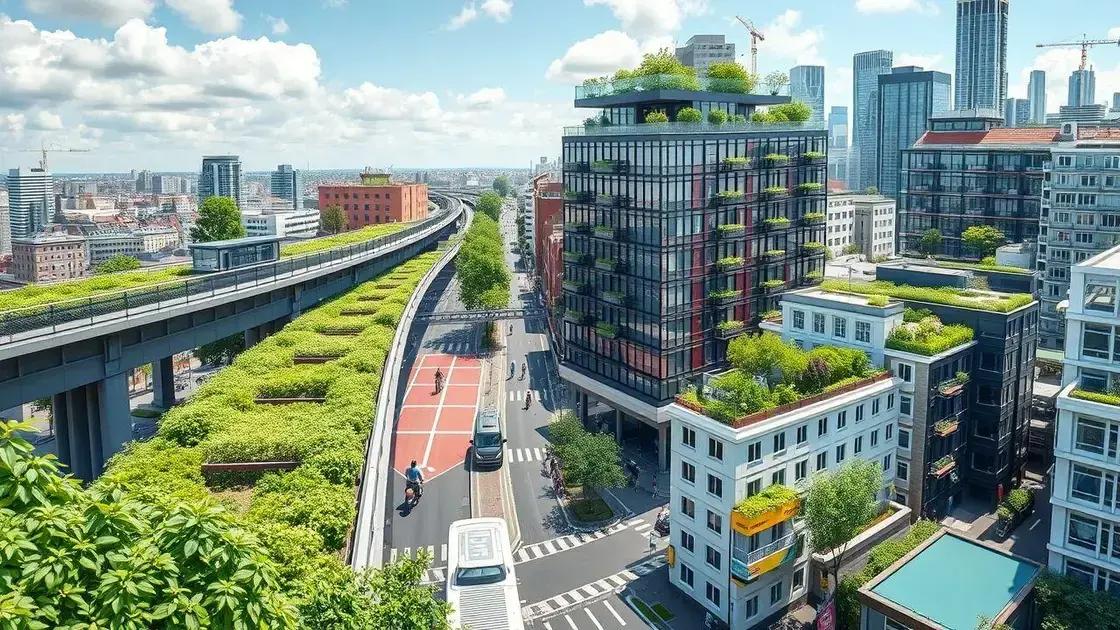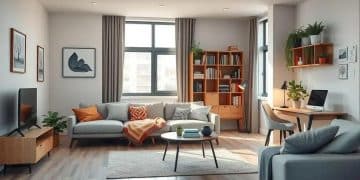Urban development initiatives that transform communities

Urban development initiatives focus on enhancing infrastructure, promoting sustainability, and improving residents’ quality of life, while facing challenges such as budget constraints and community resistance.
Urban development initiatives play a critical role in shaping our cities and communities. Have you ever wondered how these projects can enhance your neighborhood? Let’s dive into the impact of these initiatives.
Understanding urban development initiatives
Understanding urban development initiatives is essential to appreciate how they impact our daily lives. These initiatives aim to improve city environments, making them more livable and sustainable.
When cities invest in urban development, they focus on various aspects like infrastructure, housing, and public spaces. It’s fascinating to see how these efforts can change a neighborhood over time.
Key Goals of Urban Development
The primary goals of these initiatives include enhancing quality of life, promoting economic growth, and ensuring environmental sustainability. Each goal plays a pivotal role in shaping our communities.
- Quality of Life: Improved public transport and clean parks make communities vibrant.
- Economic Growth: New businesses thrive in developed areas, creating jobs.
- Environmental Sustainability: Green buildings and spaces contribute to a healthier planet.
Moreover, urban development initiatives often tackle social issues. For instance, they may focus on affordable housing, providing families with better living conditions. This is crucial for fostering inclusivity and diversity in urban settings.
As we delve deeper into specific projects, it becomes clear that collaboration among local governments, citizens, and businesses is vital. Each stakeholder brings valuable insights to create effective and enduring solutions. Community input ensures that development aligns with residents’ needs.
Innovative Strategies
Additionally, innovative strategies are utilized in urban development. For example, mixed-use developments incorporate residential, commercial, and recreational spaces into one area. This not only maximizes land use but also encourages community interaction.
Transit-oriented development is another key strategy focusing on creating neighborhoods around public transport hubs. This approach reduces reliance on cars, promoting a healthier lifestyle and decreasing traffic.
Overall, understanding these diverse aspects of urban development initiatives provides a clearer picture of their significance. They are not just about buildings or infrastructure; they are about transforming communities and enhancing the quality of life for everyone.
Key benefits for local communities

Focusing on the key benefits for local communities is essential in understanding the value of urban development initiatives. These projects bring significant improvements that can change the daily lives of residents.
One major benefit is the enhancement of local infrastructure. Improved roads, bridges, and public transport lead to easier access to jobs, education, and services. This not only reduces travel time but also promotes economic growth in the community.
Economic Growth and Job Creation
Urban development initiatives often stimulate economic growth by attracting new businesses. When businesses flourish, they create jobs, which leads to increased employment opportunities for local residents.
- Increased Investment: Development projects often attract investors, boosting local economies.
- Job Opportunities: New businesses hire locally, reducing unemployment.
- Support for Local Enterprises: Development can provide a platform for small businesses to thrive.
Additionally, these initiatives encourage social cohesion. By creating shared spaces, such as parks and community centers, they promote interaction among residents. This helps to strengthen community bonds, making neighborhoods safer and more inclusive.
Access to affordable housing is another crucial aspect of urban development. When communities focus on inclusive housing policies, families can find homes within their means, reducing issues like homelessness and housing insecurity. This contributes to a more stable and thriving community.
Environmental Improvements
Urban development can also lead to significant environmental benefits. Initiatives focusing on green spaces help enhance urban areas. Areas with parks and recreational facilities help mitigate air pollution and provide habitats for wildlife.
Implementing sustainable practices, such as green building standards and improved public transportation systems, can further reduce carbon footprints. This creates healthier living environments for all residents.
Ultimately, the key benefits of urban development initiatives contribute to more vibrant and resilient communities. Residents enjoy better access to resources, improved social interactions, and a healthier environment, paving the way for a brighter future.
Challenges faced in urban planning
Challenges faced in urban planning are numerous and can impact the effectiveness of development initiatives. Understanding these challenges is crucial for creating successful urban environments.
One significant issue is the budget constraints many cities face. Limited funding can hinder comprehensive planning and the implementation of necessary projects. As cities grow, they need adequate resources to maintain and upgrade infrastructure.
Community Resistance
Another challenge is community resistance to change. Residents may feel attached to their neighborhoods and be skeptical of new developments. This can lead to opposition, making it difficult for planners to proceed with projects that could benefit the community.
- Preserving local culture: Many communities worry that new developments might erase their cultural identity.
- Lack of trust: Past negative experiences with urban planning can breed skepticism among residents.
- Fear of gentrification: Longtime residents may fear being displaced due to rising property values.
Additionally, urban planners must consider the environmental impact of their decisions. Balancing development with sustainability can be tricky. Projects should aim to minimize harm to the environment, yet urban expansion often leads to increased pollution and habitat loss.
Moreover, integrating technology into urban planning presents its challenges. While technology can enhance planning processes, cities must ensure they have the appropriate infrastructure and training to support these tools effectively. Without the right foundation, tech integration can lead to more issues than solutions.
Regulatory Hurdles
Regulatory hurdles also complicate urban planning. Different levels of government often have various laws and regulations, making it challenging to harmonize efforts across jurisdictions. Navigating this complex web can slow down the progress of urban development initiatives.
Furthermore, ensuring equitable access to the benefits of urban planning is essential. If not addressed, disparities can arise, leaving marginalized communities with fewer resources and opportunities.
Overall, tackling these challenges requires collaboration among stakeholders, as well as creativity and persistence. Urban planning can transform communities, but it’s essential to address these hurdles to achieve lasting success.
Innovative examples from around the world

Innovative examples from around the world highlight how urban development initiatives can lead to transformational changes in communities. These examples serve as inspiration for cities looking to improve their urban landscapes.
One remarkable example is the High Line in New York City. This elevated park was created on a disused railway line. It has become a beloved green space that attracts both locals and tourists. The High Line not only provides recreational space but also promotes biodiversity in an urban environment.
Sustainable City Initiatives
In Amsterdam, innovative strategies focus on sustainability. The city has implemented extensive cycling infrastructure, making it easier for residents to use bicycles as a primary form of transportation. This initiative has significantly reduced traffic congestion and lowered carbon emissions.
- Bicycle Highways: Dedicated routes for cyclists improve safety and encourage bike usage.
- Car-Free Zones: Certain areas of the city restrict vehicular traffic, promoting walkability.
- Green Roofs: Buildings are encouraged to adopt green roofs, contributing to urban cooling.
Another stunning example is the Marina Bay Sands in Singapore. This integrated resort features a rooftop sky park, gardens, and waterways. It exemplifies how urban spaces can blend leisure with nature, creating a vibrant urban experience.
In Curitiba, Brazil, the city is a pioneer in public transportation solutions. The Bus Rapid Transit (BRT) system is widely praised and serves as a model for cities worldwide. It ensures efficient transport and reduces traffic pollution, improving the overall urban environment.
Community-Centric Developments
Community-driven projects in Medellín, Colombia, have also gained international recognition. The development of cable cars and escalators in hilly regions has improved access for low-income neighborhoods. These innovations have transformed how residents connect with the city.
Furthermore, in Freetown, Sierra Leone, the “Freetown Tree Adoption Campaign” encourages residents to plant trees. This initiative focuses on community involvement and enhances environmental awareness among citizens.
These innovative examples from around the world show that urban development is not one-size-fits-all. Each city adapts its initiatives to fit its unique needs, cultures, and challenges. Through creativity and collaboration, cities can build futuristic urban spaces that benefit all their residents.
In conclusion, urban development initiatives are essential for building better cities and improving the quality of life for everyone. By understanding the key benefits, challenges, and innovative examples from around the world, communities can create environments that promote economic growth, sustainability, and social cohesion. Collaboration among stakeholders is crucial to ensure that urban planning meets the needs of all residents. The innovative approaches showcased can inspire other cities to adapt their strategies for sustainable urban growth.
FAQ – Frequently Asked Questions about Urban Development Initiatives
What are urban development initiatives?
Urban development initiatives are projects aimed at improving the infrastructure, environment, and quality of life in urban areas.
How do these initiatives benefit local communities?
They enhance local infrastructure, create jobs, promote sustainability, and improve social interactions among residents.
What challenges do planners face in urban development?
Planners often encounter budget constraints, community resistance, environmental impacts, and regulatory hurdles.
Can you provide examples of successful urban development projects?
Yes, examples include the High Line in New York, bicycle infrastructure in Amsterdam, and public transportation systems like Curitiba’s BRT.






